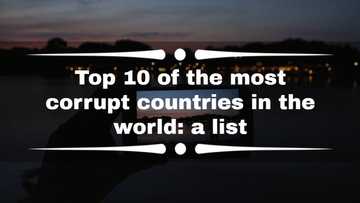Who designates whether information is classified and its classification level?
In today's world, not all information is open to the public. Certain information is classified, especially if it's sensitive or protected by law. Only people with clearance are allowed to access or handle this kind of information. Who designates whether information is classified and its classification level?

Source: Getty Images
Classified information is considered sensitive by an individual, institution or government. A designee decides whether information is classified and to what level it should be classified. Only authorised people can access such data, and authorisation is needed to access it.
Who designates whether information is classified and its classification level?
Information classification is grouping information according to sensitivity and level of protection required. This step is vital in safeguarding sensitive data of a country or an organisation. Designating the information that should be classified and determining to what extent to classify it is governed by established laws and guidelines.
Who is responsible for classifying information?
The data owner is responsible for categorising it. The owner could be a government, an organisation, or an individual.
Governments and institutions have a body known as the classification authority responsible for designating classified information. They also decide the classification levels each piece of information falls into. In the United States, for example, the Original Classification Authority (OCA) has the mandate of categorising national security material.
Levels of classified information

Source: Getty Images
Data classification is vital in protecting information and creating cyber awareness of sensitive data. There are different levels of classifying data, each indicating the level of sensitivity. The main ones are top secret, secret, and confidential. Below are levels of classification of information.
1. Top Secret
This category is the highest level of information classification. Information is classified as "Top Secret" if it could severely harm the country's interests. Examples include information about the design of nuclear weapons, specifics of intelligence satellite capabilities, and the identities of undercover operatives.
2. Secret
Information is classified as secret if it could result in significant harm to the interests of the country or organisation. It is protected against unauthorised access. A few examples include:
- Sensitive diplomatic correspondence.
- The development of cutting-edge weaponry.
- Comprehensive knowledge of intelligence sources and techniques.
3. Confidential
Information is classified as confidential if it could jeopardise national security if made public. Examples of confidential information include locations of military outposts, active military operations, and the identities of intelligence operatives.
4. Sensitive But Unclassified
The information in this category is not classified for reasons of national security. It is information that requires administrative supervision and protection against unauthorised disclosure. Examples include attorney-client privileged information, export-controlled information (ITAR, EAR), and IT security information.
5. Official
The designation is applied to information meant only for official use and needs protection even though it is not classified. It contains details that, if made public, could endanger people.

Read also
No more 90-day trial: New Zealand updates work visa to allow construction workers, IT, others
Official is a level restriction comparable to the US Department of Defense's classification For Official Use Only (FOUO). The content contains a range of data with different levels of sensitivity and loss or compromise effects.
6. Unclassified
The word "unclassified" refers to data that was previously thought to be sensitive, but now it's not. Due to its sensitivity, unclassified information is neither classified nor needs special security measures. However, it must still be handled carefully and discreetly.
7. Clearance
Clearance is a generic classification based on a need-to-know criterion. You must present the required documents and a valid need-to-know reason to access material at this level.
8. Compartmented information
Information that has been compartmentalised has been given distinct departmental keywords. It's a comprehensive risk-based level for protecting official intelligence sources.
Colour coding of classified documents

Source: UGC
Colour coding makes it simple to recognise classified information. Higher classes use distinctive font styles and colours. Below is how classified documents are color-coded.
- Top Secret: Yellow/orange
- Secret: Red
- Confidential: Blue
- Controlled: Purple
- Unclassified: Green
FAQs
- What is classified information? It is data that an organisation or a government agency deems sensitive and needs to be kept private.
- What are examples of classified information? Examples of classified material include military defence plans, intelligence operations, and communications with foreign governments.
- What is spillage of classified information? Spillage of classified information is leakage of highly secret information to unauthorised people.
- What are insider threats? Insider threats are potential security threats that can originate from within an organisation and can be intentionally or inadvertently destructive.
- What measures can prevent information spillage? Information leakage can be avoided by creating strong passwords, adhering to the least privilege principle, and exercising caution while exchanging information online.
- How long should classified data be protected? Classified data should be protected at all times.
- Who is responsible for classifying information? Data owners are responsible for classifying information. Governments and companies have classification authority who do the job.
Who designates whether information is classified and its classification level? It is the role of data owners. In big institutions and governments, special data classification bodies do the job.
Legit.ng published an article about Gen Z humour. Laughter is the best medicine, and having a sense of humour is attractive. Gen Z humour is hard to understand as it sometimes comes in a coded language. They share their jokes online, making it harder for older generations to understand them.
Gen Z are people born in the mid-1990s and early 2010s. They have grown up with technology, which differs from previous generations. When it comes to jokes, they are greatly influenced by social media. Find out what Gen Z humour is all about.
Source: Legit.ng





